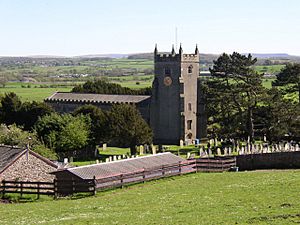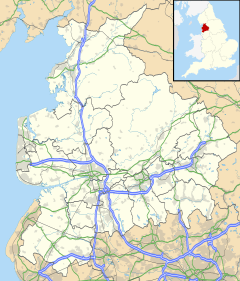Warton, Lancaster facts for kids
Quick facts for kids Warton |
|
|---|---|
 St Oswald's Church |
|
| Population | 2,360 (2011 Census) |
| OS grid reference | SD500726 |
| Civil parish |
|
| District | |
| Shire county | |
| Region | |
| Country | England |
| Sovereign state | United Kingdom |
| Post town | CARNFORTH |
| Postcode district | LA5 |
| Dialling code | 01524 |
| Police | Lancashire |
| Fire | Lancashire |
| Ambulance | North West |
| EU Parliament | North West England |
| UK Parliament |
|
Warton is a village in Lancashire, England. It is located in the Lancaster area, close to the border with Cumbria. The village is about 1.5 miles (2.4 km) north of Carnforth. In 2011, Warton had a population of 2,360 people. The area around Warton is mostly countryside.
Warton is mentioned in the Domesday Book from 1086, which was a big survey of England. The village is home to the Warton Old Rectory, which are the ruins of a house built for a clergyman a long time ago. The main church, St Oswald's Church, has a special connection to the Washington family. This family includes George Washington, who was the first President of the United States.
Contents
Discover Warton's Past
Warton has a long and interesting history, stretching back over a thousand years.
St Oswald's Church: A Timeless Landmark
The exact beginning of St Oswald's Church is not fully known. People believe the church was built long before 1066, when the Normans conquered England. The oldest part of the church is its south wall, which dates back to the 1300s. The first known priest for the church was recorded in 1190.
Warton's Early Importance
By the early 1200s, Warton became an important stop for travelers heading north to places like Carlisle and Scotland. Because of its location, King John allowed Warton to have a market every Wednesday in 1200. This meant people could come to Warton to buy and sell goods. Later in the 1200s, Warton was given "borough status." This showed how important Warton was for trade and business at that time.
The Old Rectory: A Medieval Home
The oldest building still standing in Warton, besides the church, is the ruined rectory. It was built around 1267. This large stone house was home to the wealthy rectors (church leaders) of Warton. It even had a great hall and chambers, and was used as a courthouse. The ruins are still in good condition today, with some walls standing almost 30 feet (9 meters) tall. English Heritage now looks after these historic ruins.
The Washington Family Connection
Warton is famous for being the home of the medieval ancestors of George Washington. He was the first popularly elected President of the United States. Lawrence Washington, who lived about seven generations before George Washington, came to Warton around 1300. It's even said that Robert Washington, Lawrence's great-grandson, helped build the clock tower at St Oswald's Church.
The Washington family's coat of arms (their special family symbol) can be seen in the church. This symbol, with three stars and two stripes, is believed to have inspired the design of the flag of the United States. Every year on the Fourth of July, the American flag is flown on the church flagpole. This flag was given to the village after American soldiers visited Warton during World War II. They learned about the Washington family's link to the village and later sent a flag that had flown over the Capitol Building in Washington D.C.
Village Growth and Industry
Warton continued to grow in the 1500s and 1600s. Many houses were built along Main Street, which runs through Warton and nearby villages.
For a long time, Warton was a small producer of limestone from Warton Crag. But when steam trains were invented, the limestone industry grew very quickly. This caused Carnforth, a small village nearby where the railway station was, to become much bigger than Warton in just a few decades. You can still find old lime kilns (ovens used to process limestone) around Warton Crag.
As Carnforth's iron industry and railways grew, Warton became a place for workers to live. Many affordable terraced houses were built around the early 1900s. By the 1940s, Warton had two council estates, many shops, and at least two pubs. The village has also had a cricket club since 1907, and they won their league championship for the first time in 2007.
Warton's Parish Area
The old parish of Warton was much larger than it is today. It included several nearby areas like Borwick, Carnforth, Priest Hutton, Silverdale, and Yealand Conyers. Today, the civil parish of Warton has specific borders set in 1935. It is surrounded by other parishes and extends onto the sands of Morecambe Bay to the west.
Population Information
In 2011, the population of Warton civil parish was 2,360 people.
See also
 In Spanish: Warton (Lancaster) para niños
In Spanish: Warton (Lancaster) para niños


